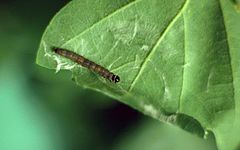bio.wikisort.org - Animal
Archips xylosteana, the variegated golden tortrix or brown oak tortrix, is a moth of the family Tortricidae.
Distribution
This Palearctic moth is widespread in most of Europe, in Asia (China, Iran, Japan, Kazakhstan, Korea, Siberia, Turkey), and in northern Africa (Algeria).[2][3][4]
Habitat
This moth species inhabit woodland and scrub in hilly and mountainous areas. [5][6]
Description
Archips xylosteana is a medium-sized to large moth with a wingspan reaching 14–23 millimetres (0.55–0.91 in).[6] The females are usually slightly larger than the males. The basic color of the fore wings varies from yellow-brown or ocher to pinkish brown, mottled with dark reddish brown markings. Forewings are broad and roughly rectangular. Hind wings are light grayish brown. [4] The design of the wings may appear lightly asymmetric, because at rest one of the wing covers the other[4] and hides part of it. The caterpillar varies from whitish gray to bluish with greenish reflections and have a black head. [4] Meyrick describes it - Forewings with termen sinuate, vertical, costal fold from base to 3/5, irregular ; ochreous more or less fuscous-tinged, paler towards costa ; a transverse dorsal spot near base, central fascia with anterior edge sinuate, costal patch broadly connected with it near costa, a blotch from above tornus sometimes connected with costal patch, and an apical spot dark ferruginous-brown. Hindwings grey, apex sometimes yellowish-tinged. Larva whitish-grey or pale greenish ; head black ;plate of 2 black, anterior edge white.[7] Julius von Kennel provides a full description. [8]
Biology
These moths fly from June to August in one generation.[4][6] They rest during the day in the foliage of trees and shrubs. Their activity begins at dusk. [6] They overwinter on tree trunks and thick boughs.
Caterpillars grow protected in a rolled leaf, perpendicularly to the midrib, from April to June. These larvae are polyphagous, feeding on various shrubs and deciduous trees, [4] mainly oak (Quercus), elm (Ulmus), linden (Tilia), hazel (Corylus), maples (Acer), ash (Fraxinus, firs (Abies), brambles (Rubus), honeysuckle (Lonicera) and St John's worts (Hypericum)). [5] They can also be found on various fruit trees (apple, pear, etc.) [9] and on some herbaceous plants.
Gallery
- Caterpillar
- Moth, side view
- Moth, female
- Mounted specimen. Male
Bibliography
- Linnaeus, C. (1758): Systema naturae per regna tria naturae, secundum classes, ordines, genera, species, cum characteribus, differentiis, synonymis, locis. Tomus I. Editio decima, reformata. 1-824. Holmiae (Laurentius Salvius).
- Robinson, G. S. & E. Schmidt Nielsen (1983): The Microlepidoptera described by Linnaeus and Clerck. — Systematic Entomology 8: 191-242.
References
- Tortricidae.com
- Funa europaea
- Revision of Tribe Archipini (Tortricidae: Tortricinae) in Northeast China
- IDtools
- "Suffolk Moths". Archived from the original on 2018-05-11. Retrieved 2018-05-11.
- UK Moths
- Meyrick, E., 1895 A Handbook of British Lepidoptera MacMillan, London pdf
 This article incorporates text from this source, which is in the public domain. Keys and description
This article incorporates text from this source, which is in the public domain. Keys and description - Julius von Kennel, 1921, The Palaearktischen Tortriciden, eine monographische Darstellung. Stuttgart: E. Schweizerbart'sche Verlagsbuchhandlung. 742 pp. - Palaearctic Tortricidae, a monograph.pdf at Zobodat 130- 131
- Historische Lepidopteren-Literatur / Schütze (1931)
External links
Другой контент может иметь иную лицензию. Перед использованием материалов сайта WikiSort.org внимательно изучите правила лицензирования конкретных элементов наполнения сайта.
WikiSort.org - проект по пересортировке и дополнению контента Википедии




